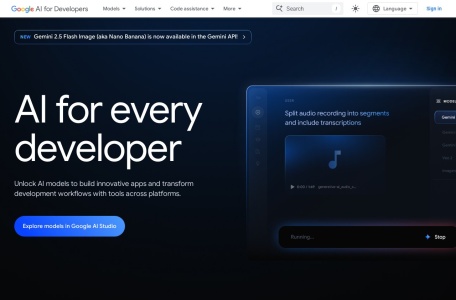
What is Eureka?
Eureka is not a commercial product in the traditional sense, but rather a groundbreaking AI agent developed by NVIDIA Research. It’s a novel framework that uses a large language model (LLM) to autonomously generate and improve reward functions for training robots. In simple terms, Eureka teaches a robot how to perform a task by creating the code that tells the robot what a “good” or “bad” performance looks like. The AI agent starts with a simple natural language prompt (e.g., “make the robot balance a cube”) and then writes, tests, and refines thousands of lines of code to create an optimal reward function, all without human intervention. This process allows robots to learn intricate physical skills with unprecedented speed and precision, bypassing the slow and manual process of human-defined reward shaping.
Key Features
- LLM-Powered Code Generation: Eureka uses an LLM to write and optimize reward functions, allowing robots to learn complex skills from natural language instructions.
- Autonomous Skill Discovery: The agent can independently learn and master skills without a human expert needing to manually design the training environment or feedback.
- Self-Improving Loop: Eureka continuously refines the reward function code based on the robot’s performance, creating a closed loop of automated learning and optimization.
- Broad Skill Application: The framework has been successfully used to teach robots a wide variety of skills, from complex object manipulation and tool use to juggling and balancing.
- Accelerated Robot Training: It significantly reduces the time and effort required to train a robot on new physical tasks, accelerating research and development in robotics.
Official Website
You can learn more about Eureka AI and the research behind it on the NVIDIA Research blog: https://research.nvidia.com/eureka
How to Use
As a research framework rather than a commercial tool, Eureka is primarily used in robotics research and development environments.
- Define the Task: A researcher or engineer provides a high-level, natural language description of the physical task they want the robot to learn (e.g., “open a drawer”).
- Eureka Generates Rewards: Eureka’s AI agent analyzes the task and autonomously generates the code for a reward function.
- Robot Training: The robot then uses this reward function to train itself in a simulated environment, with Eureka continuously fine-tuning the code for better performance.
- Master the Skill: The process repeats until the robot has mastered the skill, demonstrating a high degree of proficiency in the task.
Application Scenarios
Eureka’s technology has profound implications for the future of robotics and automation:
- Advanced Robotics Research: Researchers can use Eureka to rapidly prototype and train robots to perform complex tasks that were previously too difficult or time-consuming to teach.
- Industrial Automation: The technology could be used to train robots in manufacturing and logistics to perform intricate tasks with high precision and efficiency.
- Service Robots: It has the potential to enable service robots to learn new physical skills on the fly, adapting to new environments and tasks in a domestic or public setting.
- Simulated Environments: The framework is particularly useful for training robots in simulated environments before deploying them in the real world, reducing risks and costs.
Relevant Navigation


Consensus AI – AI Search for Academic Research

Perplexity AI – AI Research Assistant & Search Engine

Gauth: AI Math Homework Solver & Tutor

Grammarly AI – AI Writing Assistant for Students & Academics

DeepSeek V3: Powerful Open-Source AI Model & API
Copilot

